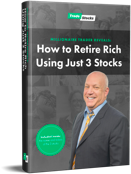
10 Options Strategies to Use Right Now
There are so many options trading tips and tricks that we could go on for days. Overwhelming as it may seem, just one strategy could change the trajectory of your entire career.
Here are 10 options strategies you can try right now.
1. Selling Weekly Options
Weekly options have become more and more popular in recent years. In efforts to provide further means of obtaining desired exposure and additional means of hedging exposure, exchanges have added weekly option listing to many products including certain stocks, indices and futures contracts.
While these weekly options may potentially provide profit opportunities, they may also provide a great way to get your ass handed to you fast.
Weekly options are often discussed in option writing circles due to their limited timeframe of exposure and rapid decay rates. While these are both potentially positives for those looking to collect premiums, these options often carry low corresponding premiums and high gamma risk.
For example: Stock ABC is currently trading at $80 per share and is often quite volatile. A put option that expires at the end of the first week of the month and has a strike price of $75 is trading at a premium of $.25. While once could potentially sell that option and keep the $.25 in premium if the stock stays above $75 at expiration, what happens if the stock makes a large and sudden move lower?
The value of that put option could potentially increase many times over producing significant losses. One may be forced to close the option at a loss or may have to take delivery of the shares at the strike price of $75. If the stock were to fall to $65, for example, one could be looking at losses of nearly $10 per share.
Not a very good deal is it?
Like any other type of trading, one must always consider risk versus reward.
Trading is all about risk management. If you are looking at selling weekly options to try to generate income, you must understand the risks involved. Naked option selling can produce losses over and above your initial investment. Such trading is certainly not suitable for all investors. There are ways, however, to quantify these risks. One can look to sell credit spreads, for example, to manage position risk.
2. Covered Call Writing
Covered call writing can be a way for investors to potentially boost returns while also mitigating risk. Calls can be written against long positions in stocks or other instruments.
When looking for stocks to write covered calls against, there are some things you may want to look for in order to try to make the most of this strategy. Some of the things you may want to look for in a stock include:
- Sideways price behavior
- Slight uptrend
- Pays a dividend
- Exhibits some degree of volatility
For example, own 100 shares of stock ABC. You purchased 100 shares at an average price of $32 per share. The stock is currently trading at $35 per share and has been in a range from $32 to $36 per share for the last year.
Now that the price is reaching the top end of its trading range, you can consider writing a call against your long shares. You do not expect the stock to trade above $37 per share, and therefore elect to sell a front month $37 call option for a premium of $.40.
One of three things could happen:
- The option expires worthless and you keep the premium collected
- The stock rises and you elect to buy the option back
- The stock rises above the short call strike price and your shares are called away
The beauty of the strategy is that it puts the unstoppable power of time to work for you rather than against you. The stock can go up, down or sideways and the option may still be losing value.
Of course, if you are wrong and the stock price rises too far. You’ll have to decide whether to close the short call at a potential loss or risk having your shares called away.
3. The Long Straddle
What is a position you can use to try to capitalize on a big market move when you don’t know what direction that move will take?
One position that may potentially suit your needs is the long straddle.
The long straddle gives you the potential to profit regardless of market direction, defined risk and the potential to profit from an increase in implied volatility
Of course, you can also lose money trading straddles.
A long straddle is the purchase of both an at-the-money call and at-the-money put of the same strike and expiration.
A long straddle may potentially be most effective when you are looking for a very significant directional move and when implied volatility is relatively low.
You are looking for the extent of the move to exceed the total premium paid for the options and/or for a large increase in implied volatility.
For example, stock ABC is trading at $50 per share and has an earnings announcement due to be released. You think that the stock may make a huge move but do not know in which direction.
You decide to purchase a front month straddle by purchasing the $50 call for $5 and the $50 put for $5. The total premium paid is $10, therefore, you will need the stock price to move plus or minus $10 in order to make a profit at expiration. Anything less than a $10 move will cause losses dollar for dollar up to $10. A full $10 loss of premium paid could occur if the stock price stays right at $50 at expiration and both options expire worthless.
In addition, time decay will eat away at a straddle rapidly and must be accounted for when considering such a position.
4. The Butterfly Spread
The butterfly spread is a versatile yet often misunderstood options spread. The butterfly spread gets its name from its wings and the size of the spread’s wings can be adjusted according to trade objectives and risk tolerance.
A simple way to look at a long butterfly spread using call options is the simultaneous purchase and sale of a call spread.
For example, you believe shares of ABC are likely to rise from their current level of $20 per share. You also believe, however, that the shares will not likely go any higher than $22 per share. Volatility has also been on the high side recently and you therefore elect to initiate a butterfly spread using calls. You purchase the at-the-money $20 call option, sell two of the $22 call options and purchase one of the $24 call options.
What have you effectively done? You have purchased the $20/$22 call spread and sold the $22/$24 call spread.
Since you believe the stock price may rise, but only to a degree, you sell the $22/$24 call spread to help finance the purchase of the $20/$22 call spread.
This type of spread is put on at a net debit, and that net debit represents the maximum exposure on the trade.
Maximum profit is reached if the stock price is right at the middle strike, or body of the butterfly, at expiration. In this case, the long call spread reaches full intrinsic value while the short call spread expires worthless.
5. How to demystify the effects of time decay
Options values and modeling can become quite complicated, but they can also follow some very simple rules. If you’re new to options, one of the most critical elements to understand is the element of theta, or time decay. Theta measures the rate of decline of an option’s value due to the passage of time.
Read on to find out how to demystify the effects of time decay.
A Waste of Time?
Options are a wasting asset, and as such, they literally “bleed” value as they approach their expiration dates (assuming they are out-of-the-money). All other things being equal, an option will lose value as it approaches expiration. This rate of decline is exponential in nature, speeding up as the expiration date approaches.
Options have two types of value: Intrinsic value and extrinsic value. Intrinsic value is any value the option has from being in-the-money. Extrinsic value is the time value of an option. As an option gets closer to expiration, extrinsic value decreases until the option expires worthless or if in-the-money is exercised or settled for cash.
What to do When Trading Options
There are a few things you need to think about when trading options. If you are net long options, then theta works against you. If you are net short options, then theta is your friend and works in your favor. Theta accelerates exponentially as expiration approaches, and out-of-the-money options are comprised of extrinsic or time value only.
For example, the mini SP500 futures contract is currently trading at the 2000 level. Investor Bill believes it will go higher, and decides to purchase the out-of-the-money front month 2020 call option for a premium of 1 point, or $50 in this case. This $50 premium is comprised entirely of time value.
One week after Bill purchased the call option, the mini SP500 futures contract is still trading right around the 2000 level. Now, however, Bill’s long call option has lost over half its value, and is only worth $20. All other inputs have remained constant, and Bill’s option has lost value due to the passage of time.
Conversely, the trader that sold the call has seen theta work in his or her favor. If they sold the call for a premium of one, ($50), and it’s now only valued at $20, then he or she has a “paper” profit of $30. If the option ends up expiring worthless, Bill will lose his entire $50 investment while the trader that sold the call will make $50.
When it comes to options trading, you can be right but still be wrong. The effects of time decay must be considered when looking at potential strategies and positions.
6. The Bull Call Spread
The bull call spread is a long options position with a bullish bias. It may have several advantages over the purchase of outright long calls including less sensitivity to time decay (theta) as well as implied volatility (vega). Whether it’s used with stock options or options on futures, the bull call spread may provide more efficient use of capital. While a bull call spread may limit risk, it also limits potential gains.
How Does a Bull Call Spread Work?
Here are the basic steps to a bull call spread:
- Look for a market that you are bullish on at current levels
- Look for a call to purchase that is at or near the current price or that is where you think prices are likely to go
- Sell a call option that is deeper-out-of-the-money than the call that you purchased
- Decide on an exit point of the trade goes against you
- Decide on a point at which you will take profits
What Are Some Issues When Using a Bull Call Spread?
The spread is usually put on as a single trade. In other words, you can initiate the position with the call purchase and call sale together for a net price. You can also “leg” into the trade if you are a more sophisticated trader. Keep in mind though, that your maximum gains are limited to the difference between strike prices minus the premium paid for the spread. Not only that, but bull call spreads are also debit spreads, meaning it will cost you money to put one on. If the market is between the strike prices at expiration, your long call may be exercised into a long position in the underlying instrument.
For example, Investor Bill has been watching crude oil futures drop from $80 per barrel to $50 per barrel in just a few months time. Bill believes that oil is not likely to fall below $50 per barrel and he wants to take a bullish position. The at-the-money $50 call options (with 60 days until expiration) are quite expensive, trading for a premium of 500 or $5000 per call option.
Bill decides to initiate a bull call spread and purchases the two month $52 call option for a premium of 300 or $3000 and sells the two month $57 call option for a premium of 100 or $1000. Investor Bill’s net outlay for the trade is $2000. This amount represents his maximum exposure on the trade (not including commissions and fees). The profit potential of the trade is limited to the difference in strike prices $57-$52 equals $5 minus the premium paid of $2000. Therefore, if crude oil is above the short strike of $57 at expiration, Investor Bill can make a maximum profit of $3000 not including commissions or fees.
Basically, you need to look at the pros and cons of the bull call spread and decide if it’s the right strategy for you. No matter what, you’re taking on some sort of risk.
7. Binary Options
Binary options have become more popular in recent years largely due to their simplicity and defined risk characteristics. It’s a financial instrument, specifically an option, that either expires in-the-money or out-of-the-money. It can’t do anything else.
Essentially, you are placing a bet with a yes or a no. Binary options have values from 0 to 100. A zero value indicates the option expired out-of-the-money and worthless while a value of 100 indicates the option expired in-the-money.
For example, let’s assume there is a binary option on the price of corn closing above $3.60 at the end of the day session. With one hour until expiration, the price of corn is trading at $3.56. A binary option quote may look something like this:
ZC15>$3.60 (1:15 p.m.)
BUY—-SELL
$30 $70
If you were to buy this binary option, you are betting that the price of corn will be greater than the strike price of $3.60 at expiration. Since the maximum value of the option can only go to 100, you are risking $30 to potentially make $70.
If you were to sell this binary option, you are betting that the price of corn will be less than the strike price of $3.60 at expiration. Since the minimum value of the option can only go to zero, you are risking $70 to potentially make $30.
Binary options can have varying expirations from hours to days to weeks to a year. Binaries are also available for trading on many markets. The Nadex Exchange, for example, lists binary options on stock indexes, currencies, commodities and more.
The same methods that are used for trading other instruments can also be applied to binary options. Technical analysis such as trend lines, patterns, volume studies and more may all potentially be useful.
Perhaps the biggest appeal for trading binaries is their defined risk and low cost of entry. Because a contract can only be worth zero or $100 at expiration, the risk per contract is always limited. You have to have enough funds in your account to cover any potential losses, so there are no margin calls or losses exceeding your account balance.
You can trade a binary option with as little as $100 in your account. In addition to the low capital requirements, commissions and fees may also be quite reasonable.
Be careful of unregulated companies that charge “juice” on winnings. This “juice” will increase your overall costs and can make it extremely difficult to earn any consistent profits.
8. Sell Cash Secured Puts
The key here is to sell cash-secured puts on a stock that you aren’t really keen on owning. Let’s assume for a moment that you own shares of stock ABC which is currently trading at $30 per share. However, you’d rather own it if it’s at $26 instead. You may want to consider writing a cash-secured put for every 100 shares of stock you would be comfortable owning if the stock exhibits some volatility. If the stock has seen prior support at the $27 level, you could look to sell at $26 put if the shares pull back.
The puts may become overinflated on such a pullback as investors who are long on the stock get nervous and scramble to buy puts to protect their long positions. If you sell a $26 put and the stock moves back up, your put may expire worthless and you keep the premium collected.
In contrast, if the stock moves below the $26 strike price at expiration, you may be assigned a long position in the shares from $26-a position you already decided you wouldn’t mind having. Plus, you still keep the premium collected.
9. Sell On Stock Market Declines
You could look to sell put premium on stock market declines of 10 percent or more using index products such as the SPX or SPY. While double digit declines don’t occur frequently, they do happen and may present opportunities to sell highly overvalued put premiums. For example, if the S&P 500 gaps lower and opens the trading day down 40 or 50 handles, investors may be scrambling to buy puts to hedge their portfolios. These investors are willing to pay up to do so.
In such a scenario, you might consider the sale of a put spread. For example, if the S&P opens lower by 50 points at 1990, you may be able to sell put spreads that are another 5 to 10 percent out-of-the-money or more and receive a decent premium for the risk you are taking. If you were instead to sell a 1890/1900 put spread on the SPX, the market would have to move another five percent plus for your spread to go in the money.
While the risk of loss certainly exists, the spread could potentially profit if implied volatility levels decline or the passage of time erodes the option values. If the market is above the short strike of 1890 at expiration, you keep the premium collected.
10. Sell Iron Condors
The key is to sell iron condors on markets whose implied volatility levels are at or near their six or 12 month highs. While many people might associate the iron condor with a range-bound market, the strategy can also be very useful for capturing over-inflated option premiums.
Often times, IV levels will rise in an options market due to an upcoming announcement such as earnings. For example, stock XYZ may have traded in a range for the last two months yet its option values are trading near the high end of their six month IV range. This may be due to an upcoming earnings announcement set for release in a few weeks.
You think that the announcement will likely be a non-event and the stock will continue to trade within its current range. In this case, you might consider selling an iron condor. With shares of XYZ currently at $45 per share, you might consider something like selling the front month $50/$55 call spread and front month $35/$40 put spread.
If the option values are overvalued, you may potentially profit from mean reversion in IV levels. You could also potentially profit from time decay as well. If the stock is between the short strikes or $40 and $50 at expiration, all options will expire worthless and you keep the premium collected.
Options can be used in many other ways in an attempt to capture over-inflated premiums. Other strategies such as ratio spreads, covered calls and iron butterflies may all potentially offer a method for collecting rich option premiums. To be successful using such strategies, you must become intimately familiar with implied volatility, risk management and option mechanics.
It should go without saying that all of these strategies carry risk. Markets can and do make extended moves that appear to defy logic. While the opportunity for profit exists, so does an equal or even greater opportunity for loss. Always make sure you understand the risks involved with any type of strategy or trade before doing it. If you aren’t willing to assume those risks-which in some cases may be unlimited – you may want to stick with defined risk strategies.

















